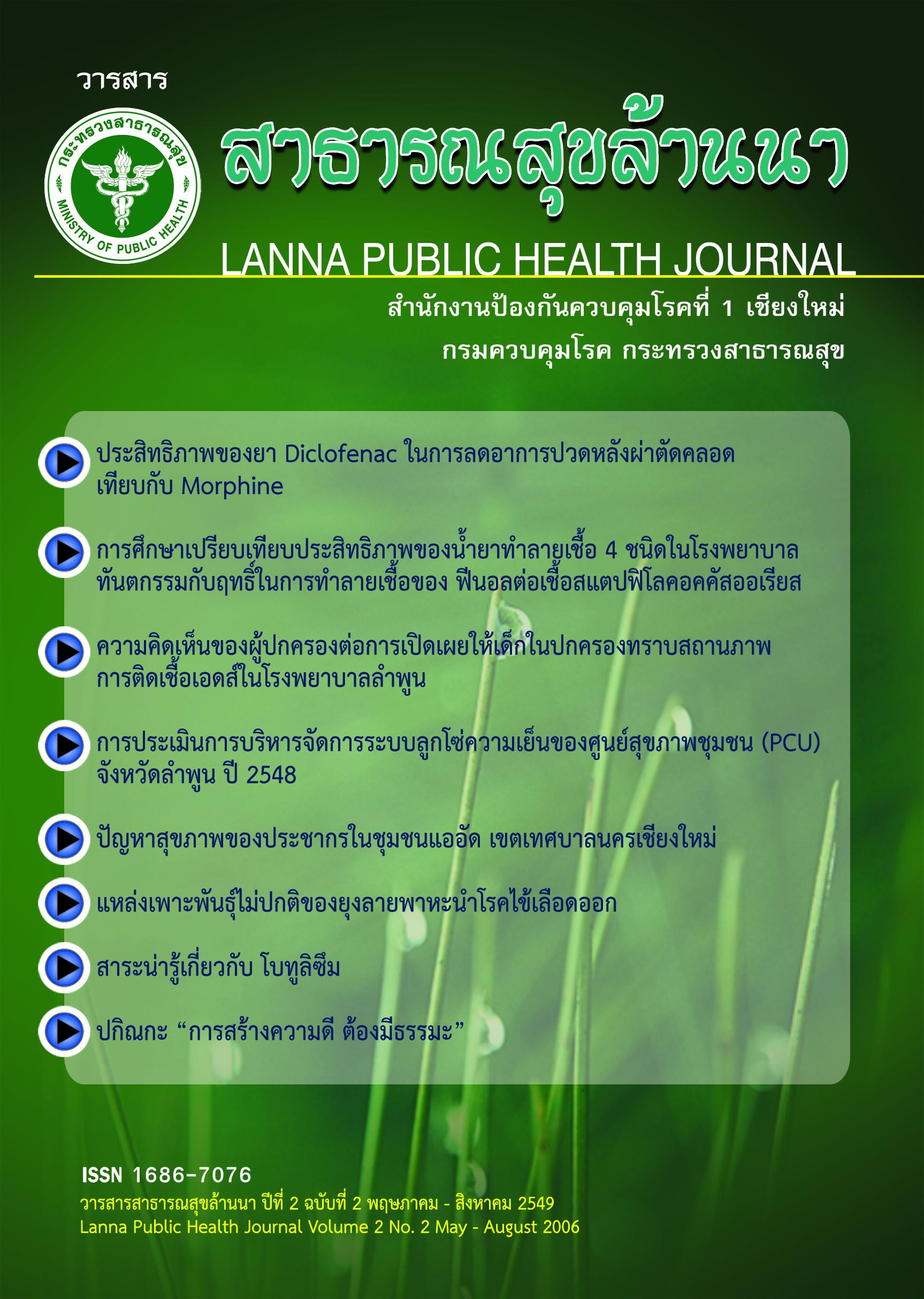แหล่งเพาะพันธุ์ไม่ปกติของยุงลายพาหะนำโรคไข้เลือดออก
คำสำคัญ:
น้ำสกปรก, ลูกน้ำยุงลาย, การควบคุมยุง, จังหวัดเชียงใหม่บทคัดย่อ
การขยายตัวของเขตเมืองเป็นสิ่งที่เกิดขึ้นเกือบทุกประเทศทั่วโลกรวมทั้งประเทศไทย ซึ่งเป็นสาเหตุที่ทำให้เกิดภาวะสิ่งแวดล้อมเป็นพิษ เป็นสิ่งสนับสนุนในการเพิ่มประชากรของพาหะนำโรค รวมถึงยุงมีผลกระทบมาสู่สุขภาพของมนุษย์โดยรวม ประเทศในเขตร้อนส่วนมาไม่มีระบบรองรับการขยายตัวของเมือง เช่น ระบบการกำจัดขยะ ระบบสาธารณูปโภค น้ำดื่ม น้ำใช้ เป็นเหตุให้ประชาชนต้องมีการเก็บน้ำ ไว้ใช้ยามจำเป็น ซึ่งเป็นการเพิ่มแหล่งเพาะพันธุ์ยุงลายพาหะนำโรคไข้เลือดออก ในขณะที่การคมนาคม และระบบขนส่งมวลชน มีการพัฒนาและขยายอาณาเขต ทำให้การกระจายของยุงพาหะตลอดจนเชื้อไวรัสไข้เลือดออกเป็นไปอย่างกว้างขวางด้วยเช่นกัน เป็นที่ทราบกันดีแล้วว่ายุงลาย ชนิดอีจิปไตย์ และอโบพิคตัส เป็นยุงพาหะนำเชื้อไข้เลือดออกในประเทศไทย ตามปกติยุงลายสอบชนิดนี้ มีนินัยวางไข่ในแหล่งน้ำขังที่ใสสะอาด การศึกษาครั้งนี้ดำเนินการในเขตอำเภอเมือง จังหวัดเชียงใหม่ โดยทำการสำรวจลูกน้ำยุงลายในแหล่งน้ำเน่าเสีย โดยมีวัตถุประสงค์เพื่อทราบว่า ยุงลายสามารถวางไข่ในน้ำเน่าเสียได้หรือไม่ เพื่อการวางแผนการควบคุมยุงลาย พาหะไข้เลือดออกได้อย่างเหมาะสม ผลการศึกษา จากการสำรวจแหล่งน้ำเสียทั้งหมด 20 แหล่ง พบลูกน้ำยุงรำคาญชนิด ควินเคียฟาสเซียตัส 99.9%(6,261/6,263) ที่เหลืออีก 0.04๔ (2/6,263) เป็นยุงก้นปล่องชนิดบาร์บริรอสติส และยุงยักษ์ โดยไม่พบลูกน้ำยุงลาย พาหะไข้เลือดออกในทุกแหล่งน้ำที่ได้รับการสำรวจ
เอกสารอ้างอิง
Maltingly PF. Genetical aspects of the Aedes aegypti, Annals of Tropical Medicine and Parasitology. 1953; 51:392-408.
Scott TW, Clark GG, Amerasinghe PH, Lorenz LH, Reiter P, and Edman JD. Detection of multiple blood feeding patterns in Aedes aegypti (Diptera: Culicidae) during a single gonotrophic cycle using a histological technique.J. Med. Entomol. 1993; 30:94-99.
Seamic Health Statistics. International Medical Foundation of Japan. SEAMIC Publication No 6(2003); http://www.seamic-imfjl.or.jp
http:///wwwlldd.go.th/FAO/z-th/th.htm เข้าถึงข้อมูลมีนาคม 2549
Rattanarithikul R, Harrison BA, Panthusiri P and Coleman RE. Illustrated keys to the mosquito of Thailand I Background, geographic distribution, Lists of genera, subgenera, and species and a key to the genera. Southeast Asia J. Trop. Med. Public Health 2005; 36 supplement 1:80
Rueda LM> Pictorial key for the identification of mosquitoes (Diptera: Culicidae) associated with dengue virus transmission online edition Zootaxa. 2004; 589: 1-60.
WHO Preventing dengue and dengue haemorrhagic fever. A fact sheet for municipal and community leaders. WHO. Genera. CTD/FIL(DEN)/94.4:14.
Hanison BA, Boonyakanist P and Mongkolpanya K. Biological observations on Aedes seatoi in Thailand with notes on rural Aedes aegypti (L.) and other Stegomyia populations. Journal of Medical Entomology. 1972; 9: 1-6.
Suwonkerd W, Tsuda Y, Takagi M and Wada Y. Seasonal occurrence of Aedes aegypti and Aedes albopictus in used tires in 1992-1994, Chiang Mai, Thailand. Tropical Medicine 1996; 38(3/4): 101-105.
Bond HA and Fay RW. Factors influencing Aedes aegypti occurrence in containers. Mosquito News. 1969; 29(1): 113-116.
ประพัฒน์ ญาณทักษะ และวรรณา สุวรรณเกิด การศึกษายุงก้นปล่องชนิดมินิมัสนอกแหล่งเพาะพันธุ์ปกติที่จังหวัดพะเยา.วารสารโรคติดต่อ 2537; 20 (3): 195-201.
Ishii T. An unusual indoor larval habitat of Adeds albopictus (Skuse) in Japan (Diptera: Culicidae). Jpn J Sanit Zool 1987; 38 (4): 339-340.








